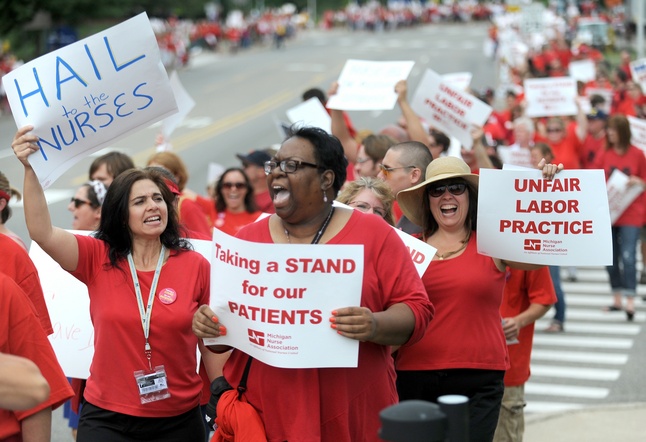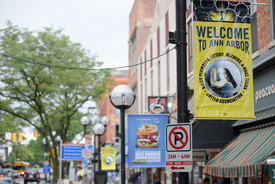
University of Michigan nurses march during a contract dispute last summer.
Angela J. Cesere | AnnArbor.com
According to the US Department of Labor website, Labor Day was intended to entail “a street parade to exhibit to the public ‘the strength and esprit de corps of the trade and labor organizations’ of the community.” The closest Labor Day parade to Washtenaw County is in Detroit, but this year's holiday seems an appropriate time to take stock of some of the trends affecting the local labor movement.
Here are five observations I’ve come to after talking with labor leaders and experts from around the county.
Just because you don’t see them doesn’t mean they aren’t active
Unions are pushing a ballot initiative to amend the Michigan Constitution to include a guaranteed right to collective bargaining. The "Protect Our Jobs" measure has been approved but also challenged, and should be decided early this month.
The vote would follow two years of Michigan policy changes - including the emergency manager law - that threaten the power of unions. At the same time, some in Michigan, including Representative Mike Shirkey (R-Clark Lake), have continued to push for "Right To Work" laws that restrict the ability of unions to operate in the state.
Governor Rick Snyder has attempted to chart a middle course. He has urged lawmakers to refrain from authoring legislation that would restrict collective bargaining rights while at the same time discouraged the unions from attempting to enshrine those rights in the state constitution. Snyder says that both efforts are too incendiary for the current political climate.
Yet on-the-ground labor disputes have been few and far between in Washtenaw County over the past few years. Fred Veigel and Wesley Prater, the president and vice-president of the Huron Valley Central Labor Council, said the last picket line they participated in was more than two years ago due to a dispute over the use of non-union construction workers.
However, just because they aren’t in the news, doesn’t mean that they aren’t very active behind the scenes.
“I’ve been on both sides of the equation, and even when I was a manager, I preferred to work with unions,” Prater said.
“If it’s working properly and you get good leadership in the union and leadership from the administration of the company, it all seems to go better.”

The county welcomes the UA and other unions every year as they run training programs at local campuses.
Angela Cesere | AnnArbor.com
Roland Zullo, a research scientist at the Institute for Research on Labor, Employment, and the Economy at the University of Michigan, said that despite a lack of significant heavy manufacturing, Washtenaw County has a stronger union movement than most of the rest of the state.
“A part of why we have such a strong union movement here is the many large service sector employers,” he said.
“For services, especially education and health-care we’ve seen a growth nationwide in union membership, and we obviously have a lot of those employees here in the county.”
Michigan just saw a jump in statewide union involvement
According to the Bureau of Labor Statistics, between 2001 and 2010 the percentage of employed Michiganders represented by unions fell from 22.1 to 17.3 percent. During that same period, Michigan's total number of employed citizens fell from 4.48 million to 3.79 million, a loss of more than 650,000 jobs.
That fall coincided with declines in the auto industry that led to Michigan’s economy becoming a national punch-line. Veigel said the correlation is no coincidence.
“It’s no surprise that union jobs go down when the economy goes down,” he said.
“We lead into depressions and out of them. It’s not just the building and remodeling that we do, it’s everything that we handle: the paint, the pipes, the refrigerators, everything.”
The rate of union representation jumped back up to 18.3 percent in 2011. That jump has coincided with a leveling off Michigan's job hemorrhage. According to BLS data, Michigan's number of employed residents bottomed out in 2009 at 3.79 million jobs and has risen slowly the past two years. Michigan's unemployment rate also peaked in 2009 at 14.2 percent and has been slowly dropping since (with the exception of small increases the past three months).
Local numbers for union participation aren't available, but the Ann Arbor area also saw its lowest employment numbers in mid-to-late 2009. The region has consistently outpaced the state and non-seasonaly adjusted numbers indicated that there were 172,147 employees in the area leading to an unemployment rate of 6.8%
Liberal politicians make unions happy
A large number of Washtenaw County union members are in public-sector unions. These unions negotiate directly with the government, and politicians who are committed to working with the unions make it much easier for them to succeed.
“What I’ve been impressed with is the willingness by the county to sit down and negotiate and work with the public employees rather than resorting to more draconian methods when there are budget difficulties,” Zullo said.
“The other approach is to slash the public workforce and rely on private contractors. This is a key determinant as to whether or not the unions exist.”
The willingness of unions to work with officials has also helped relations between the two sides. Earlier this month the Ypsilanti teachers agreed to take a 12.7 percent cut in pay and benefits as part of cost-cutting measures in the district.
as do large universities.
The University of Michigan is the largest single employer in the county, and Zullo said they are constantly involved in negotiations with various unions.
“I believe [they] negotiate with seven different labor unions,” he said.
While Eastern Michigan University’s negotiations with their various unions have at times been tense , they, along with U-M and Washtenaw Community College, tend to work with unions not only when it comes to employment, but also for campus construction.
“One of the biggest factors for union’s health is the construction industry,” Greg Stephens, business manager at IBEW electrician’s union Local 252, said.
Zullo agreed, and added that the commitment by local universities to hire union workers for their construction has helped ease the pain during the recession.
High-tech workers not joining the unions yet
One of the fastest growing industries in the county, especially in downtown Ann Arbor, is the high-tech sector. It is extremely rare to find workers organizing in these newer companies and union organizers say they aren’t surprised.
“As long as they’re treating people well and paying them a decent salary with benefits, you won’t see unions organizing,” Veigel said.
“But if the leaders of these companies start getting greedy and lining their pockets at the expense of the workers, you see them start to organize.”
Some unionizing efforts have begun in Silicon Valley, Zullo said, but it’s primarily among temporary tech workers.
“The other reason the tech industry might start to organize is to protect the rights of older workers,” he said.
“Historically, seniority rights has been a major motivator for workers to organize. My image from outside the industry is that tech companies are always trying to bring in the freshest youngest talent. It will be interesting to see how some of the workers who are more senior are treated.”
Ben Freed covers business for AnnArbor.com. Reach him at 734-623-2528 or email him at benfreed@annarbor.com. Follow him on twitter @BFreedinA2